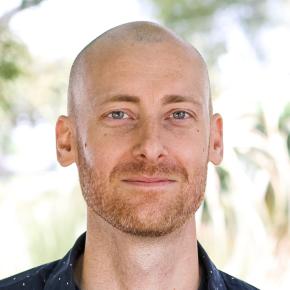When should we begin teaching our kids that Christianity is defensible? This question was on my mind as I began putting together another chapel talk for Innova Academy, the classical Christian school my daughters attend. (See “Teaching Worldview to Kids” to read about my last chapel talk.)
How early should we talk about arguments for the existence of God, or the reliability of the Bible, or the problem of evil, or a whole host of other issues? The answer is, as early as possible.
Now, I know what some of you might be thinking, “Get real, Tim. Are you saying we should teach the kalam cosmological argument to kindergarteners or fine-tuning to five-year-olds?”
Yes, that’s exactly what I’m saying. And here’s how.
Throw the Ball so They Can Catch It
When I began working at Stand to Reason, Greg Koukl taught me something that has stuck with me. It’s something I constantly think about as I’m creating new presentations. It’s a simple dictum: Throw the ball so the audience can catch it. The principle could also be stated, know your audience.
When I think about how we’ve been able to effectively communicate difficult topics to junior high and high school students, this aphorism holds true. We are able to teach students because we have trained ourselves to think like students. And once we are able to think like our audience, we’re able to translate the material so they can understand it.
In this case, my audience ranged from four-year-olds to fourteen-year-olds. So what was the “ball” I wanted them to catch? I wanted them to understand—even if only at a basic level—why God would allow bad things to happen.
Here’s How I Did It
Rather than jumping right into a response, I wanted to be sure each student understood the concept of badness.* To do this, I began by asking for some of their favorite stories. One student raised her hand and said, “Frozen.” Another student said, “Snow White.” A third emphatically stated, “Star Wars.”
After putting a list together, I made an observation. Each of these stories contains some badness. And much of the badness comes from a bad guy—the villain.
To illustrate this point, I put a number of famous villains on the screen. The students immediately recognized these bad guys as well as the badness they caused.
This led to another important observation. We all recognize when someone is being bad, including the four-year-olds in my audience. No one has to tell us who the bad guys are. We all recognize when things aren’t the way they should be.
Badness in the Real World
So far we had only talked about made-up stories. They are not real. However, they tap into something true about the real world; namely, there is badness in the world.
In the real world, things happen that we call evil or bad. For instance, people take things that don’t belong to them. People don’t always tell the truth. People fight for no good reason. People get sick and suffer. And all of these things seem wrong to us—like they aren’t supposed to be this way. That is, we know things ought to be different.
A Good God Made a Good World
At this point, we have established that from an early age we recognize that the world isn’t the way it ought to be. There is something wrong with the world. It’s broken.
So, where did wrongness or badness come from? The Christian worldview gives the answer. All we need to do is read the first three chapters of Genesis.
Genesis 1 uses the word “good” seven times to describe the world that God had made. The chapter ends with these striking words, “And God saw everything that He had made, and behold, it was very good.”
Therefore, the original world contained no sickness, no tears, no conflict, no suffering. Adam and Eve had a perfect relationship with God, each other, and the creation. There was no badness.
So, what happened? Well, just keep reading. Everything changed in Genesis 3. God put Adam and Eve in a perfect garden—called Eden—and gave them a single rule to follow. They could eat the fruit of every tree but one.
At this point, I asked the students, “Do you know what happened?” One student said, “Adam and Eve broke the rule.” She was right. They chose to disobey God, and this choice had catastrophic consequences.
Here’s how I summarized: “When Adam and Even broke the rule, they also broke the world.” Therefore, the current state of the world is not the way the world was originally created. We live in a world that humanity broke, and this broken world produces broken people and broken circumstances.
Free Will Makes Badness Possible
From the Fall forward, the world was a very different place. I think it is fair to ask, “Why didn’t God stop Adam and Eve from eating the fruit?” Furthermore, why doesn’t God just stop people from doing bad things altogether?
Here’s part of the answer. When God created Adam and Eve, He gave them the freedom to choose between right and wrong, good and bad. They could use their free will to obey God, or they could use their free will to disobey God.
God could have created robots that are forced to always do good. But a robot could never enter into a genuine love relationship with God. Instead, God wanted to create human beings who could freely choose to love Him. But this kind of freedom allowed for the possibility of badness.
To help drive home this important point, I had the students compare my relationship with Siri—on my phone—and my relationship with my daughters. First, I pulled out my phone and asked Siri, “Who am I?”
Siri replied, “Your name is Tim, but since we are friends, you asked me to call you the love of my life.”
Next, I invited my daughters onto the stage. Without telling them what to say, I asked each of them, “Do you love me?”
With a big smile on their faces, they each declared—in their own words—their love for me.
The difference between these two declarations was clear. Siri may have said she loves me, but we all know that this wasn’t real love. In fact, the only reason she called me the love of her life was because I programmed her to. This was not a free decision.
My daughters, on the other hand, were created with the ability to freely choose to love me. There was no programming, no forcing, no coercing. Likewise, Adam and Eve used their freedom to disobey God and bring evil into the world.
God Allows Badness to Bring Goodness
There is something else that needs to be taken into account. I told the students, “God allows badness to bring goodness.” That is, God allows some bad things to happen in this world for a good purpose—even if we never know what that purpose is.
This is actually fairly simple to illustrate to kids. I asked the students, “How many of you have been to the doctor to get a shot?”
Every student raised his or her hand. “Good,” I said. “And how did it feel?”
The response was unanimous. Shots are painful.
I’ve taken each of my girls to get their shots, and each time, it’s heartbreaking. Young children don’t understand the reason for getting shots. They don’t realize that this particular pain is for their benefit. The shot is meant to help them even though it might temporarily hurt them.
In the same way, God permits pain and suffering in our lives that can serve a good purpose. This explanation is perfectly consistent with the Bible.
I had the students think about how Jesus suffered an excruciating death on a cross. I asked the rhetorical question, “What good could possibly come from all that badness?”
I’ll tell you what came from it: salvation for the world.
The prophet Isaiah put it this way:
But He was pierced for our transgressions,
He was crushed for our iniquities;
the punishment that brought us peace was on Him,
and by His wounds we are healed. (Isa. 53:5)
We can be saved—and have eternal life—because of the crucifixion of Jesus. God can bring good out of evil and suffering. How do we know? Because He’s done it before.
The Story Isn’t Over Yet
I wanted to leave the students with one final thought. It makes no sense to stop in the middle of a story—any story—and complain that it didn’t turn out right. After all, the story isn’t finished.
This would be akin to watching Snow White and the Seven Dwarfs and stopping in the middle of the movie to complain about how Snow White is stuck under a sleeping spell and never going to wake up.
We know that would be foolish because the movie isn’t over yet. In fact, we know there is a happy ending to the story.
In the same way, Christians know how the story of reality ends. God will right every injustice. No bad deed will go unpunished. All the badness in the world will finally and ultimately be judged.
Furthermore, God will reward the righteous—those who have put their trust in Him. And God will make new heavens and a new earth, and there will be no more pain and suffering. As Christians who experience badness in the world, we look forward to that blessed hope.
In this short chapel talk, we covered one of the most difficult questions that any Christian can face. I did my best to translate the challenge and some of the responses in a way that each student could understand. Did every student comprehend every point? No. But I’m convinced every student left the chapel better equipped than when they entered.
*I intentionally chose to use the term “badness” over “evil” to help the younger students connect it with bad things that happen in the world. This would be an example of throwing the ball so they can catch it.

